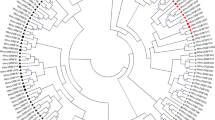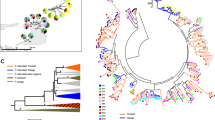Abstract
Strong spatiotemporal variation in population size often leads to reduced genetic diversity limiting the adaptive potential of individual populations. Key genes of adaptive variation are encoded by the immune genes of the major histocompatibility complex (MHC) playing an essential role in parasite resistance. How MHC variation persists in rodent populations that regularly experience population bottlenecks remains an important topic in evolutionary genetics. We analysed the consequences of strong population fluctuations on MHC class II DRB exon 2 diversity in two distant common vole (Microtus arvalis) populations in three consecutive years using a high-throughput sequencing approach. In 143 individuals, we detected 25 nucleotide alleles translating into 14 unique amino acid MHC alleles belonging to at least three loci. Thus, the overall allelic diversity and amino acid distance among the remaining MHC alleles, used as a surrogate for the range of pathogenic antigens that can be presented to T-cells, are still remarkably high. Both study populations did not show significant population differentiation between years, but significant differences were found between sites. We concluded that selection processes seem to be strong enough to maintain moderate levels of MHC diversity in our study populations outcompeting genetic drift, as the same MHC alleles were conserved between years. Differences in allele frequencies between populations might be the outcome of different local parasite pressures and/or genetic drift. Further understanding of how pathogens vary across space and time will be crucial to further elucidate the mechanisms maintaining MHC diversity in cyclic populations.

Similar content being viewed by others
References
Andreassen HP, Glorvigen P, Remy A, Ims RA (2013) New views on how population-intrinsic and community-extrinsic processes interact during the vole population cycles. Oikos 122:507–515. doi:10.1111/j.1600-0706.2012.00238.x
Axtner J, Sommer S (2007) Gene duplication, allelic diversity, selection processes and adaptive value of MHC class II DRB genes of the bank vole. Clethrionomys Glareolus Immunogenet 59:417–426. doi:10.1007/s00251-007-0205-y
Babik W, Durka W, Radwan J (2005) Sequence diversity of the MHC DRB gene in the Eurasian beaver (Castor fiber). Mol Ecol 14:4249–4257. doi:10.1111/j.1365-294X.2005.02751.x
Baláž I (2010) Somatic characteristics and reproduction of common vole, Microtus arvalis. Biologia 65:1064–1071
Berthier K, Charbonnel N, Galan M, Chaval Y, Cosson JF (2006) Migration and recovery of the genetic diversity during the increasing density phase in cyclic vole populations. Mol Ecol 15:2665–2676
Bondinas GP, Moustakas AK, Papadopoulos GK (2007) The spectrum of HLA-DQ and HLA-DR alleles, 2006: a listing correlating sequence and structure with function. Immunogenetics 59:539–553. doi:10.1007/s00251-007-0224-8
Borkowska A, Ratkiewicz M (2010) Promiscuity, male reproductive success and mate relatedness in a natural population of the common vole. J Zool 280:195–201
Boyce CC, Boyce JL (1988) Population biology of Microtus arvalis. III. Regulation of numbers and breeding dispersion of females. J Anim Ecol 737–754
Brown JH, Jardetzky T, Saper MA, Samraoui B, Bjorkman PJ, Wiley DC (1988) A hypothetical model of the foreign antigen-binding site of class II histocompatibility molecules. Nature 332:845–850. doi:10.1038/332845a0
Brown JH, Jardetzky TS, Gorga JC, Stern LJ, Urban RG, Strominger JL, Wiley DC (1993) 3-Dimensional structure of the human class-II histocompatibility antigen HLA-DR1. Nature 364:33–39. doi:10.1038/364033a0
Bryja J, Galan M, Charbonnel N, Cosson JF (2006) Duplication, balancing selection and trans-species evolution explain the high levels of polymorphism of the DQA MHC class II gene in voles (Arvicolinae). Immunogenetics 58:191–202. doi:10.1007/s00251-006-0085-6
Bryja J, Charbonnel N, Berthier K, Galan M, Cosson JF (2007) Density-related changes in selection pattern for major histocompatibility complex genes in fluctuating populations of voles. Mol Ecol 16:5084–5097. doi:10.1111/j.1365-294X.2007.03584.x
Castro-Prieto A, Wachter B, Sommer S (2011) Cheetah paradigm revisited: MHC diversity in the world’s largest free-ranging population. Mol Biol Evol 28:1455–1468. doi:10.1093/molbev/msq330
de Bellocq JG, Charbonnel N, Morand S (2008) Coevolutionary relationship between helminth diversity and MHC class II polymorphism in rodents. J Evol Biol 21:1144–1150. doi:10.1111/j.1420-9101.2008.01538.x
Delattre P, De Sousa B, Fichet-Calvet E, Quere JP, Giraudoux P (1999) Vole outbreaks in a landscape context: evidence from a six year study of Microtus arvalis. Landsc Ecol 14:401–412. doi:10.1023/a:1008022727025
Doherty PC, Zinkernagel RM (1975) Enhanced immunological surveillance in mice heterozygous at H-2 gene complex. Nature 256:50–52. doi:10.1038/256050a0
Eccard JA, Herde H (2013) Seasonal variation in the behaviour of a short-lived rodent. BMC Ecol 13
Eccard JA, Klemme I (2013) Reducing mortality of shrews in rodent live trapping—a method increasing live-trap selectivity with shrew exits. Ann Zool Fenn 50:371–376
Eccard JA, Jokinen I, Ylonen H (2011) Loss of density-dependence and incomplete control by dominant breeders in a territorial species with density outbreaks. BMC Ecol 11:8pp
Excoffier L, Laval G, Schneider S (2005) Arlequin (version 3.0): an integrated software package for population genetics data analysis. Evol Bioinforma 1:47–50
Froeschke G, Sommer S (2005) MHC class II DRB variability and parasite load in the striped mouse (Rhabdomys pumilio) in the Southern Kalahari. Mol Biol Evol 22:1254–1259. doi:10.1093/molbev/msi112
Gauffre B, Berthier K, Inchausti P, Chaval Y, Bretagnolle V, Cosson J-F (2014) Short-term variations in gene flow related to cyclic density fluctuations in the common vole. Mol Ecol 23:3214–3225. doi:10.1111/mec.12818
Gauffre B, Galan M, Bretagnolle V, Cosson JF (2007) Polymorphic microsatellite loci and PCR multiplexing in the common vole, Microtus arvalis. Mol Ecol Notes 7:830–832
Hedrick PW, Hurt CR (2012) Conservation genetics and evolution in an endangered species: research in Sonoran topminnows. Evol Appl 5:806–819. doi:10.1111/j.1752-4571.2012.00259.x
Herde A, Eccard JA (2013) Consistency in boldness, activity and exploration at different stages of life. BMC Ecol 13
Hušek J et al (2013) Cyclicity and variability in prey dynamics strengthens predator numerical response: the effects of vole fluctuations on white stork productivity. Popul Ecol 55:363–375
Imholt C, Reil D, Eccard JA, Jacob D, Hempelmann N, Jacob J (2014) Quantifying the past and future impact of climate on outbreak patterns of bank voles (Myodes glareolus). Pest Manag Sci 71:166–172. doi:10.1002/ps.3838
Jukes TH, Cantor CR (1969) Evolution of protein molecules. Mamm Protein Metab 3:132
Klein J, Bontrop RE, Dawkins RL, Erlich HA, Gyllensten UB, Heise ER, Jones PP, Parham P, Wakeland EK, Watkins DI (1990) Nomenclature for the major histocompatibility complexes of different species: a proposal. Immunogenetics 31:217–219
Kuduk K, Johanet A, Allaine D, Cohas A, Radwan J (2012) Contrasting patterns of selection acting on MHC class I and class II DRB genes in the Alpine marmot (Marmota marmota). J Evol Biol 25:1686–1693. doi:10.1111/j.1420-9101.2012.02537.x
Meyer-Lucht Y, Sommer S (2009) Number of MHC alleles is related to parasite loads in natural populations of yellow necked mice, Apodemus flavicollis. Evol Ecol Res 11:1085–1097
Meyer-Lucht Y, Otten C, Puettker T, Sommer S (2008) Selection, diversity and evolutionary patterns of the MHC class II DAB in free-ranging Neotropical marsupials.cxx BMC Genet 9 doi:10.1186/1471-2156-9-39
Moreno-Cugnon L, Esparza-Baquer A, Larruskain A, Garcia-Etxebarria K, Menne S, Gonzalez-Aseguinolaza G, Jugo BM (2015) Characterization and genotyping of the DRB1 gene of the major histocompatibility complex (MHC) in the Marmota monax, animal model of hepatitis B. Mol Immunol 63:505–512. doi:10.1016/j.molimm.2014.10.011
Musolf K, Meyer-Lucht Y, Sommer S (2004) Evolution of MHC-DRB class II polymorphism in the genus Apodemus and a comparison of DRB sequences within the family Muridae (Mammalia: Rodentia). Immunogenetics 56:420–426. doi:10.1007/s00251-004-0715-9
Nei M, Gojobori T (1986) Simple methods for estimating the numbers of synonymous and nonsynonymous nucleotide substitutions. Mol Biol Evol 3:418–426
Oliver MK, Piertney SB (2012) Selection maintains MHC diversity through a natural population bottleneck. Mol Biol Evol 29:1713–1720. doi:10.1093/molbev/mss063
Oliver MK, Telfer S, Piertney SB (2009) Major histocompatibility complex (MHC) heterozygote superiority to natural multi-parasite infections in the water vole (Arvicola terrestris). Proc R Soc B-Biol Sci 276:1119–1128. doi:10.1098/rspb.2008.1525
Pedersen AB, Greives TJ (2008) The interaction of parasites and resources cause crashes in a wild mouse population. J Anim Ecol 77:370–377. doi:10.1111/j.1365-2656.2007.01321.x
Penn DJ, Damjanovich K, Potts WK (2002) MHC heterozygosity confers a selective advantage against multiple-strain infections. Proc Natl Acad Sci U S A 99:11260–11264. doi:10.1073/pnas.162006499
Piertney SB, Oliver MK (2006) The evolutionary ecology of the major histocompatibility complex. Heredity 96:7–21. doi:10.1038/sj.hdy.6800724
Radwan J, Biedrzycka A, Babik W (2010) Does reduced MHC diversity decrease viability of vertebrate populations? Biol Conserv 143:537–544. doi:10.1016/j.biocon.2009.07.026
Smith MJ, White A, Sherratt JA, Telfer S, Begon M, Lambin X (2008) Disease effects on reproduction can cause population cycles in seasonal environments. J Anim Ecol 77:378–389. doi:10.1111/j.1365-2656.2007.01328.x
Sommer S (2005) The importance of immune gene variability (MHC) in evolutionary ecology and conservation. Front Zool 2 doi:10.1186/1742-9994-2-16
Sommer S, Courtiol A, Mazzoni CJ (2013) MHC genotyping of non-model organisms using next-generation sequencing: a new methodology to deal with artefacts and allelic dropout. BMC Genomic 14 doi:10.1186/1471-2164-14-542
Soveri T et al (2000) Disease patterns in field and bank vole populations during a cyclic decline in central Finland. Comp Immunol Microbiol Infect Dis 23:73–89. doi:10.1016/s0147-9571(99)00057-0
Spurgin LG, Richardson DS (2010) How pathogens drive genetic diversity: MHC, mechanisms and misunderstandings. Proc R Soc B-Biol Sci 277:979–988
Stein GH (1958) Die Feldmaus (Microtus arvalis Pallas). A. Ziemsen
Stenseth NC (1999) Population cycles in voles and lemmings: density dependence and phase dependence in a stochastic world. Oikos 87:427–461. doi:10.2307/3546809
Sutton JT, Nakagawa S, Robertson BC, Jamieson IG (2011) Disentangling the roles of natural selection and genetic drift in shaping variation at MHC immunity genes. Mol Ecol 20:4408–4420. doi:10.1111/j.1365-294X.2011.05292.x
Tamura K, Stecher G, Peterson D, Filipski A, Kumar S (2013) MEGA6: molecular evolutionary genetics analysis version 6.0. Mol Biol Evol 30:2725–2729. doi:10.1093/molbev/mst197
Tkadlec E, Stenseth NC (2001) A new geographical gradient in vole population dynamics. Proc R Soc B-Biol Sci 268:1547–1552. doi:10.1098/rspb.2001.1694
Winternitz JC, Wares JP (2013) Duplication and population dynamics shape historic patterns of selection and genetic variation at the major histocompatibility complex in rodents. Ecol Evol 3:1552–1568. doi:10.1002/ece3.567
Winternitz JC, Wares JP, Yabsley MJ, Altizer S (2014) Wild cyclic voles maintain high neutral and MHC diversity without strong evidence for parasite-mediated selection. Evol Ecol 28:957–975. doi:10.1007/s10682-014-9709-8
Wright S (1965) The interpretation of population structure by F-statistics with special regard to systems of mating. Evolution 395–420
Yan C, Stenseth NC, Krebs CJ, Zhang Z (2013) Linking climate change to population cycles of hares and lynx. Glob Chang Biol 19:3263–3271. doi:10.1111/gcb.12321
Acknowledgments
We would like to thank all students and field assistants who trapped common voles over the 3 years of this study. We appreciate the technical support provided by Anke Schmidt und Susan Mbedi and thank Mark Gillingham for language corrections. We are grateful to two anonymous referees for providing very helpful comments on a previous draft of this MS.
Author information
Authors and Affiliations
Corresponding author
Electronic supplementary material
Below is the link to the electronic supplementary material.
ESM 1
(DOCX 76 kb)
Rights and permissions
About this article
Cite this article
Schuster, A.C., Herde, A., Mazzoni, C.J. et al. Evidence for selection maintaining MHC diversity in a rodent species despite strong density fluctuations. Immunogenetics 68, 429–437 (2016). https://doi.org/10.1007/s00251-016-0916-z
Received:
Accepted:
Published:
Issue Date:
DOI: https://doi.org/10.1007/s00251-016-0916-z




